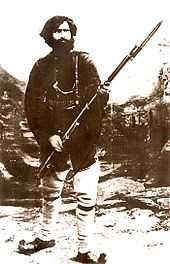Aleksandar Turundzhev

Aleksandar Kicev Turundzhev (Bulgarian: Александър Кичев Турунджев; Macedonian: Александар Турунџев) was a Bulgarian revolutionary from Ottoman Macedonia and leader of the Lerin cheta of the Internal Macedonian Adrianople Revolutionary Organization.
Biography
He was born in 1872 in the village of Ekshi su in Monastir Vilayet (today Ξινό Νερό - Xino Nero in Amyntaio, Greek Macedonia). He joined the IMARO while he was young as a rebel and took part in terrorist operations. Since 1902 he is a rebel under the command of the Bulgarian officer Georgi Papanchev, but after his death in May, by June 1903 he becomes a voyvoda of the cheta in Lerin (today Florina, Greece).
In the time of the Ilinden Uprising he played a big part in the battles in the territory around Lerin. During all the years of illegal residence and movement, Turundzhev regularly surrounded the villages in Lerin and some in Lower Prespa and Bitola. Becoming popular because of their courage and zeal for the natural aspirations of their own people to win freedom with weapons in their hands. In addition he was a strong man, athletic, tall, with lush shaggy hair, high forehead and eagles view.
He was a dear guest everywhere, because with the rebels drove the biggest thugs and executioners in Lerin, and those who wished did not venture to become the new oppressors and torturers of the local adherents of Bulgarian Exarchate,[1] because of the great fear of Turundzhev.
Ilinden–Preobrazhenie Uprising
After the decision to begin a rebellion on the Salonica Congress of IMARO and its confirmation on the Smilevo Congress, Turundzhev was given the task to organize his own village and prepare it for the uprising.
When finished with the military training of his fellow villagers of all ages, but mostly aged 20–25 years, Turundzhev with all of them, about 230 people, made a training, organized several Thalia (maneuver) with that in the improvised clashes between insurgents. During the Ilinden Uprising in Lerin was fulfilled the directive given on the Smilevo Congress for guerrilla mode of warfare. Turundzhev mobilized a total of 500 fighters, with including 100 rebels from his native village.
Ottoman commanders drafted a detailed plan of the counteroffensive against Macedono-Bulgarian revolutionary, rebel units.[2][3] And to stop the uprising the vilayet authorities have made a decision to accommodate a new unit in the village of Turundzhev on 14 November 1903.
The presence of the Ottoman units did not scare the IMRO members of Ekshi su, and it didn't srop the organization's activity of Turundzhev, who began a reconstruction of the revolutionary net in his region.[4]
Death

On the end of 1904 he was betrayed by Mitre Ginkov in the village of Aetos. He was captured and taken to the Turkish court in Bitola, where he was sentenced to death. His punishment was done in public, on 29 August 1905 in front of Bitola's At-bazaar he is killed with hanging. According to the British Consul in Thessaloniki, Robert Graves, the same day several thousand citizens followed the coffin, which was covered with wreaths from the Bulgarian Church congregation.[5] His grave is in the cemeteries Saint Nedela in Bitola.[6]
References
- ↑ Революционната борба в Битолския окръг, Спомени на Георги Попхристов (писани преди 1953 г.) глава 14.
- ↑ The text of four letters between Robert Graves and P. MacGregor to R. Graves concerning thee Ilinden Uprising
- ↑ Correspondence of Daily telegraph concerning the fights during the first days of Ilinden-Preobrazhenie Uprising, Thessalonica, 13 August 1903.
- ↑ Николов, Борис Й. Вътрешна македоно-одринска революционна организация. Войводи и ръководители (1893-1934). Биографично-библиографски справочник, София, 2001., стр.172.
- ↑ Весник Его, бр. 280, 2 Јуни 2011 г. Битола jа познавам, во Битола никого не познавам! Автор: Здравко Божиновски.
- ↑ Куманов, Милен. „Македония. Кратък исторически справочник“, София, 1993.
External links
- History of Turundzhev (Macedonian)
- Song for Turundzhev
- Image from a card from the brother of Turundzhev (Bulgarian)
- Денешен-Во Битола одбележани 107 години од смртта Александар Турунџев
- Историја на Александар Турунџев
- Илюстрация Бело море, 106 години от смъртта на Александър Турунджов.